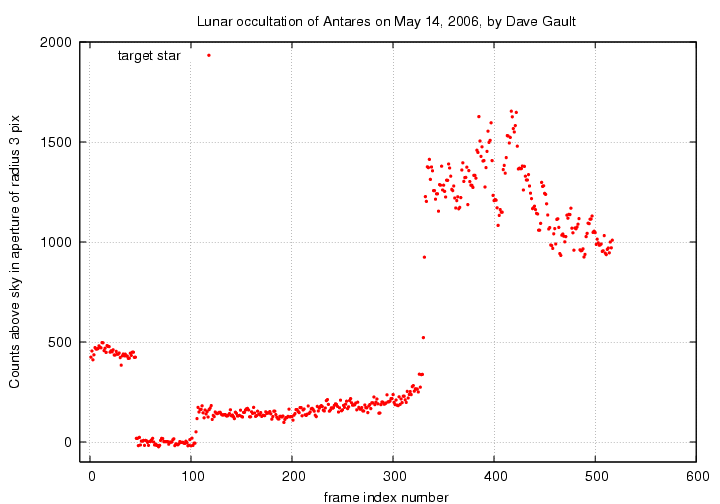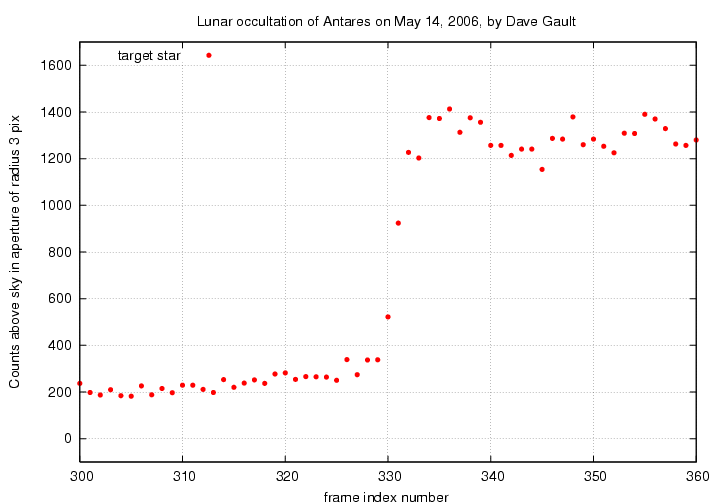
 Copyright © Michael Richmond.
This work is licensed under a Creative Commons License.
Copyright © Michael Richmond.
This work is licensed under a Creative Commons License.
This is just a very brief note on photometry of a video clip showing the reappearance of Antares and its companion from a lunar occultation, observed by Dave Gault. For the full detail, see the discussion in the kiwiosd Yahoo group , starting with Dave's initial message describing the clip.
Table of contents:
Dave Gault acquired video of Antares being uncovered by the lunar limb on May 14, 2006. He posted a video clip, about 500 frames at 352 x 240 pixels per frame, with Kiwi OSD timestamps on each frame. The link to his clip is at http://www4.tpgi.com.au/users/daveg/lunarvideos/antares_r_clip.mpg (or you can look at a local copy of the video).
First, I broke the clip into individual frames, converting them to JPEG with the mplayer tool.
In order to process the data, I
For this quick analysis, I simply placed a small box around the location of Antares in the middle of the video, and assumed the star remained in the box (it did). I then found the brightest object in the box in each frame, and measured the light within a circular aperture centered on the object. I used no comparison objects. I tried using apertures of radii 2, 3, 4 pixels, and I subtracted a local sky background based on pixels in an annulus of radii 5 to 8 pixels.
Here are quick views of the results.
First, the entire video record:

The first 50 frames or so record the brightness of a marker Dave placed to guide the eye to the location of Antares. When the marker disappears, there is no object until about frame 105, when the companion to Antares appears. Over the next 220 frames, the light from the companion grows a bit -- probably due to a slight clearing as clouds pass by. Then, around frame 330, the primary star appears from the behind the limb.
As you can see from the changes in the primary's light, the conditions weren't great. Clouds moved past, and changes in the gain of the camera caused the apparent brightness of stars to change significantly.
The difference in brightness between Antares and its companion is about 4 magnitudes in the visual. That means Antares should appear roughly 40 times brighter than the companion. However, the video record shows it only about 6 times brighter. This is (I speculate) due to saturation of the camera when Antares re-appears. The background level was high, about 50 or 60 counts, and the gain was set to show the faint companion clearly. Recall that the digitized movie has only 8 bits per pixel.
Now, a closeup of the re-appearance of the primary:

In only 3 frames, the light rises from the level of the companion alone to the level of companion plus primary. This is too little to say almost anything about possible effects due to diffraction and/or the angular extent of Antares. Let's check: Antares has an angular size of roughly 40 milliarcseconds in the visible: see A new accurate determination of the angular diameter of Antares by Richichi and Lisi, A&A 230, 355 (1990). Dave Gault computes the angular speed of the moon's limb to be 0.346 arcseconds per second, so the limb should take
0.040 arsec
t = ----------------- = 0.115 sec
0.346 arcsec/sec
Looking at my frames taken from the video, I see 516 frames covering 17.279 seconds, so each frame covers about 0.033 seconds. That means that we expect the limb to cross the angular extent of Antares in about 3.5 frames ..... and it does.
No surprises.
For the record, here is a table of my measurements:
where there is one line per frame, with columns
 Copyright © Michael Richmond.
This work is licensed under a Creative Commons License.
Copyright © Michael Richmond.
This work is licensed under a Creative Commons License.